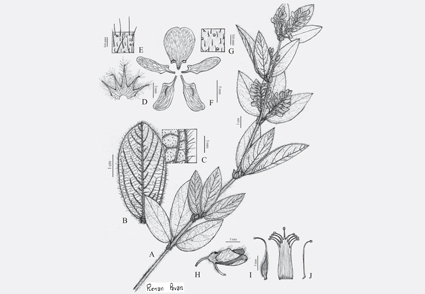Abstract
During a floristic study in Legado Verdes Cerrado region in Goiás state (Niquelândia municipality), Brazil, a new species of Eriosema genus was discovered. Eriosema magnum is here described and illustrated and its morphological similarities with its closest relatives are presented. The geographical distribution, conservation status, and information about flowering and fruiting are provided. Additionally, a dichotomous key to the taxa of Eriosema that occurs in the Legado Verdes do Cerrado was done.
References
- Bachman, S., Moat, J., Hill, A.W., de la Torre, J., Scott, B. (2011) Supporting Red List threat assessments with GeoCAT: geospatial conservation assessment tool. In: Smith, V. & Penev, L. (Eds.) e-Infrastructures for data publishing in biodiversity science. ZooKeys 150: 117–126. https://doi.org/10.3897/zookeys.150.2109
- Campos, R.P., Cândido, E.S., Zeferino, L.C. & Fortuna-Perez, A.P. (2023) A New Species of Eriosema (Leguminosae, Papilionoideae, Phaseoleae) from the savannas of northern South America. Phytotaxa 602 (3): 293–300. https://doi.org/10.11646/phytotaxa.612.3.5
- Cândido, E.S., Fortuna-Perez, A.P., Aranha-Filho, J.L.M. & Bezerra, L.M.P.A. (2014) A new species of Eriosema (Leguminosae, Papilionoideae, Phaseoleae) from Minas Gerais, Brazil. Phytotaxa 178: 229–232. https://doi.org/10.11646/phytotaxa.178.3.11
- Cândido, E.S., Vargas, W., Vatanparast, M., Mansano, V.F., Machado, S.R. & Fortuna-Perez, A.P. (2016) A new species of Eriosema (Leguminosae, Papilionoideae, Phaseoleae) from Mato Grosso do Sul, Brazil, with a secretory structure novel to the genus. Phytotaxa 263: 122–130. https://doi.org/10.11646/phytotaxa.263.2.4
- Cândido, E.S., Vargas, W., Bezerra, L.M.P.A., Mansano, V., Vatanparast, M., Lewis, G.P., Tozzi, A.M.G.A. & Fortuna-Perez, A.P. (2019) Taxonomic Synopsis of Eriosema (Leguminosae: Papilionoideae, Phaseoleae) in Brazil. Phytotaxa 416: 91–137. https://doi.org/10.11646/phytotaxa.416.2.1
- Cândido, E.S., Perez, A.P.F. & Santos-Silva, J. (2020a) Eriosema. In: Flora e Funga do Brasil. Jardim Botânico do Rio de Janeiro. Available from: https://floradobrasil.jbrj.gov.br/FB29632 (accessed: 23 April 2023)
- Cândido, E.S., Vatanparast, M., Vargas, W., Bezerra, L.M.P.A., Lewis, G.P., Mansano, V.F., Simões, A.O., Silva, M.J., Stirton, C., Tozzi, A.M.G.A. & Fortuna-Perez, A.P. (2020b) Molecular phylogenetic insights into the evolution of Eriosema (Fabaceae): a recent tropical savanna-adapted genus. Botanical Journal of the Linnean Society 20: 1–21. https://doi.org/10.1093/botlinnean/boaa059
- Candolle, A.P. de (1825) Prodromus Systematis Naturalis Regni Vegetabilis 2: 381–388.
- Desvaux, M. (1826) Observations sur la famille des Légumineuses. Annales des Sciences Naturelles (Paris) 9: 421.
- Don, G. (1832) A General History of the Dichlamydeous Plants 2: 347.
- Fortuna-Perez, A.P., Lewis, G.P., Cândido, E.S., Bezerra, L.M.P.A. & Tozzi, A.M.G.A. (2013) Eriosema hatschbachii (Leguminosae, Papilionoideae), a new species from Minas Gerais, Brazil. Kew Bulletin 68: 641–645. https://doi.org/10.1007/S12225-013-9471-Z
- Fortuna-Perez, A.P., Silva, M.J., Cândido, E.S., Vargas, W., Monteiro, T.C. & Vatanparast, M. (2017) Eriosema elegans (Leguminosae, Papilionoideae): A new species from the Highlands of Goiás State, Brazil. Phytotaxa 296 (1): 81–87. https://doi.org/10.11646/phytotaxa.296.1.6
- Fortuna-Perez, A.P., Cândido, E.S., Silva, M.J., Vargas, W., Bezerra, L.M.P.A. & Vatanparast, M. (2018) A Noteworthy New Species of Eriosema (Leguminosae, Papilionoideae, Phaseoleae) from Goiás State, Brazil, Including an Identification Key. Systematic Botany 43 (1): 198–205. https://doi.org/10.1600/036364418X697012
- Fortunato, R.H. (2016) Eriosema. In: Lista de Espécies da Flora do Brasil. Jardim Botânico do Rio de Janeiro. Available from: http://floradobrasil.jbrj.gov.br/ (accessed 14 May 2024)
- Grear, J.W. (1970) A revision of American species of Eriosema (Leguminosae—Lotoideae). Memoirs of the New York Botanical Garden 20 (3): 1–98.
- Harms, H.A.T. (1903) Botanische Jahrbücher für Systematik, Pflanzengeschichte und Pflanzengeographie 33 (Beibl. 72): 30–32.
- IUCN Standards and Petitions Subcommittee (2019) Guidelines for using the IUCN Red List Categories and Criteria. Version 14. Prepared by the Standards and Petitions Subcommittee. Available from: http://www.iucnredlist.org/documents/RedListGuidelines.pdf (accessed 29 May 2024)
- Köppen, W. (1948) Climatologia. v. 9. Fundo de Cultura Econômica. México.
- Kunth, K.S. (1823) Glycine rufa Kunth. Nova Genera et Species Plantarum (quarto ed.) 6: 423.
- Lewis, G.P., Schrire, B.D., Mackinder, B.A. & Lock, M. (eds.) (2005) Legumes of the world. The Royal Botanic Gardens, Kew, 62 pp.
- QGIS.org (2023) QGIS Geographic Information System. QGIS Association. Available from: https://www.qgis.org (accessed 28 May 2024)
- Thiers, B.M. (2024) [continuously updated] Index Herbariorum. Available from: https://sweetgum.nybg.org/science/ih/ (accessed 28 May 2024)


